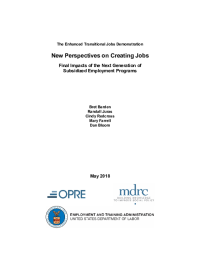New Perspectives on Creating Jobs
Final Impacts of the Next Generation of Subsidized Employment Programs

Some adults have great difficulty finding and holding jobs even when overall economic conditions are good. These individuals typically have low levels of formal education and skills, and other characteristics such as criminal records that place them at the back of the queue for job openings. Many programs have been developed to assist hard-to-employ job seekers, but few have demonstrated sustained success. One such model, “transitional jobs,” offers temporary jobs, subsidized with public funds, that aim to teach participants basic work skills or help them get a foot in the door with an employer. Several transitional jobs programs have been evaluated, with mixed results.
The Enhanced Transitional Jobs Demonstration (ETJD), funded by the Employment and Training Administration of the U.S. Department of Labor, tested seven transitional jobs programs that targeted people recently released from prison or low-income parents who had fallen behind in child support payments. The ETJD programs were “enhanced” in various ways relative to programs studied in the past. MDRC, a nonprofit, nonpartisan research organization, led the project along with two partners: Abt Associates and MEF Associates. The Office of Planning, Research, and Evaluation in the U.S. Department of Health and Human Services’ Administration for Children and Families also supported the evaluation.
The evaluation used a random assignment research design. Program group members were given access to the ETJD programs and control group members had access to other services in the community. This report presents the final impact results from the study 30 months after enrollment and information about the costs of the ETJD programs. Most measures presented in the report focus on the final year of the follow-up period, when nearly all program group members had left transitional jobs. The results therefore reflect longer-term effects of the programs after the subsidized positions ended.
-
The ETJD programs increased participants’ earnings and employment rates in the final year of the study period. The program group earned about $700 more than the control group in that year. Sixty-four percent of the program group worked in that year, compared with 60 percent of the control group. Impacts on longer-term employment outcomes are better than those found in previous evaluations.
-
The three ETJD programs targeting people returning from prison reduced incarceration in prison among those at higher risk of reoffending. Although there was no statistically significant impact on a broad measure of recidivism (the rate at which people commit new crimes or are reincarcerated), there were some encouraging patterns on other measures of recidivism. In addition, among higher-risk participants across the three locations, there was a statistically significant reduction in incarceration in prison (of 12 percentage points) in the 30 months following study enrollment. The impacts on recidivism largely reflect the program in Indianapolis, which targeted a very disadvantaged and high-risk population.
-
The ETJD programs targeting noncustodial parents did not increase the amount of child support paid in the last year of the follow-up period. However, they did increase the proportion of parents who paid at least some support during this period by 6 percentage points.
-
Results varied somewhat among the programs. Some of the ETJD programs produced statistically significant effects on notable outcome measures. However, it is unclear whether patterns in results reflect differences in models, in the implementation of the models, in contextual factors, or in the characteristics of the ETJD sample members served in each location.
- ETJD program costs ranged from about $7,000 to $11,100 per program group member. The net costs of the ETJD programs (taking control group costs and non-ETJD costs into account) ranged from about $6,200 to $11,100 per person.






